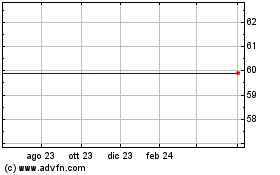By Heather Haddon and James R. Hagerty
Shelley Jones Davis was preparing a meal for a family gathering
at her home in Tacoma, Wash., on a recent Sunday evening when the
doorbell rang.
Ms. Davis was surprised -- and annoyed -- to find that her
15-year-old daughter, Maggie, had made her own dinner plans,
featuring Thai food delivered by DoorDash Inc.
"But your cousins are coming over, and I'm making chili!" Ms.
Davis told her teenager.
Ms. Davis, a sales manager for a mobile-phone maker, thought
Maggie's delivery habit had been curbed after frequent orders had
drained Maggie's debit-card account. But cash gifts during the
holidays had restored her finances. Her mom imposed a new rule: No
delivery orders without advance parental approval.
Companies such as DoorDash, Grubhub Inc. and Uber Technologies
Inc.'s Uber Eats have opened up a smorgasbord of new cuisines for
delivery, giving young people new ways to subvert parental efforts
to organize family meals.
Rita George-Tvrtkovic, an associate professor of theology living
in Chicago, recently offered to make bacon and eggs for her
15-year-old son and three friends of his who had stayed the night.
They said they weren't hungry. An hour later, an Uber Eats courier
arrived with a load of tacos.
"Don't they know mom's food is better?" Ms. George-Tvrtkovic
says.
Her son, Luka, says his friends prefer delivery. They paid for
the order.
Teenagers say they love the sense of control of ordering up food
from someone other than their parents.
"I can do it any hour. For sleepovers, we'll have McDonald's at
1:30 in the morning," says Michael Singer, a 17-year-old who lives
in Wayne, N.J. He orders through accounts paid for by his mom, Dena
Singer.
"They are all on these apps. Us parents are paying," says Ms.
Singer.
She came home one recent weekend to find Michael had used
DoorDash to conjure up a date night of fettuccini Alfredo and penne
alla vodka for his girlfriend.
The companies all have some age restrictions in their terms of
service. Many teens order on their parents' accounts.
Some parents say they don't want their kids to have such ready
access to restaurant food that federal studies show tends to
contain more saturated fat, sodium and calories than food cooked at
home
Shavon Turner, 40, who lives in the Los Angeles area, said the
meals she prepares for the seven kids in her household sometimes
lose out to Chipotle Mexican Grill Inc. burritos.
"The younger generation of kids don't appreciate home-cooked
meals as much because they're so addicted to the salt, sugar and
oil that's in the prepared foods of the world," Ms. Turner
says.
Chipotle's chief marketing officer Chris Brandt said the chain's
customizable menu allows for meals that run from nutritious to
indulgent.
"Some people load it up for this giant burrito or bowl that's as
big as your head. But you can eat as healthy as you want at
Chipotle," Mr. Brandt says.
Other adults being pulled into children's delivery orders are
worried about their own waistlines.
Cynthia Latson, a 40-year-old public-relations officer from Los
Angeles, says she's gained weight since moving in with her aunt and
her aunt's two teenagers. The kids order from restaurants roughly
five times a week, spoiling Ms. Latson's plans to make fish and
vegetables.
"It's the new laziness," Ms. Latson says.
Food-delivery services say they offer a range of restaurants
with a variety of healthy choices. A Grubhub spokeswoman says the
company delivers many kinds of food including salads, soup and rice
bowls.
Many schools across the country have banned food deliveries to
individual students. Some students are finding workarounds to get
their fix.
"It's stupid because the school lunch is disgusting," says
15-year-old Maggie Davis.
Students at a high school in Granite Bay, Calif., have tried to
circumvent a ban on food-delivery by instructing couriers to slip
their orders through gaps in the school's fence. Principal Jennifer
Leighton has threatened those enterprising young learners with
detention.
"We're not going to allow strangers on our campus to deliver
food to kids," Ms. Leighton says.
Some people well past their teenage years have also found that
their tech-enabled eating habits are out of step with those of
their parents.
According to market-research firm NPD Group, food-delivery
orders from the young members of Generation Z are growing the
fastest, but the older millennial generation still generates the
largest share of orders -- 622 million in the year ended in
November.
At home in Old Bridge, N.J., for Thanksgiving this year, Zachary
Shakked, 23, chose DoorDash instead of his dad's traditional
Thursday morning eggs. Mr. Shakked, who works as an app developer
in New York, placed his order from bed: a Taylor ham, egg and
cheese bagel, and a second with cream cheese in case he was still
hungry.
His father, Avi Shakked, a 70-year-old engineer, was surprised
to hear the doorbell ring while the pair were watching Saturday
Night Live clips, announcing the arrival of his son's bagels.
"I'm not used to waking up and ordering food," the father says.
"I just go get it." On Thanksgiving morning, he ate what he had in
the house: toast, Brie and coffee.
Some parents are in no position to lecture their children about
home cooking.
Jiao Bo, an executive for a U.S.-based maker of industrial gas
detectors in Shanghai, says he and his wife, who works in a
hospital, are so busy that they have become reliant on apps to
summon precooked meals to their home. Mr. Jiao says they let their
12-year-old daughter, Jinghan, help decide what to order.
Recently, Jinghan made a surprising request: she wanted more
home cooking.
Write to Heather Haddon at heather.haddon@wsj.com and James R.
Hagerty at bob.hagerty@wsj.com
(END) Dow Jones Newswires
January 08, 2020 12:08 ET (17:08 GMT)
Copyright (c) 2020 Dow Jones & Company, Inc.
Grafico Azioni GrubHub (NYSE:GRUB)
Storico
Da Giu 2024 a Lug 2024

Grafico Azioni GrubHub (NYSE:GRUB)
Storico
Da Lug 2023 a Lug 2024
